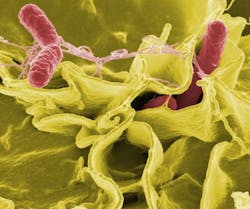Light-activated nanotherapy could thwart antibiotic-resistant bacteria
Researchers at the University of Colorado Boulder (CU-Boulder) have developed an adaptive light therapy approach to halt antibiotic-resistant infections from salmonella, E. coli, and Staphylococcus aureus bacteria, among others.
Related: UV light robot could thwart spread of hospital superbugs
Recognizing that these bacteria rapidly adapt and develop immunity to common antibiotics such as penicillin, resulting in a high amount of infection-related deaths in the U.S. (an estimated 23,000), the research team used light-activated therapeutic nanoparticles known as quantum dots. These nanoparticles resemble the tiny semiconductors used in consumer electronics, and were able to successfully kill 92% of drug-resistant bacterial cells in a lab-grown culture in their study. Prashant Nagpal, an assistant professor in the Department of Chemical and Biological Engineering at CU-Boulder and the BioFrontiers Institute and a senior author of the study, explains that their ability to shrink these semiconductors down to the nanoscale enabled them to create highly specific interactions within the cellular environment that only target the infection.
Previous research has shown that metal nanoparticles—created from gold and silver, among other metals—can be effective at combating antibiotic resistant infections, but can indiscriminately damage surrounding cells as well. The quantum dots, however, can be tailored to particular infections, thanks to their light-activated properties. The dots remain inactive in darkness, but can be activated on command by exposing them to light, allowing researchers to modify the wavelength to alter and kill the infected cells.
The specificity of this innovation may help reduce or eliminate the potential side effects of other treatment methods for diseases such as HIV and cancer, as well as provide a path forward for future development and clinical trials.
Full details of the work appear in the journal Nature Materials; for more information, please visit http://dx.doi.org/10.1038/nmat4542.
Follow us on Twitter, 'like' us on Facebook, connect with us on Google+, and join our group on LinkedIn

